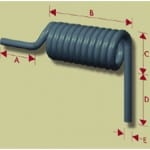Choosing a custom cable can be difficult, but understanding the design and manufacturing process can ease that burden, giving your team peace of mind knowing that they’ve produced a quality product.
Because a coiled cord’s quality can’t be determined visually, it can be tremendously difficult to determine which designers are capable of producing the highest quality product.
An experienced cable designer will be able to create a cord centered around your product’s specific needs and industry specifications. They will be able to walk you through the design process as their team of engineers gains an understanding of the product’s specific functionality and final application.
Taking the time to understand the product’s unique cabling needs is important as it ensures that your product will be made with quality materials. When crafting a coiled cord, the jacketing material needs to be durable, yet flexible enough to withstand the constant tugging and stretching that coil cords endure. The conductor inside of the cord must be able to carry the appropriate voltage and signal without without experiencing voltage drop or signal corruption. If you’re having trouble assessing whether or not the proposed custom coil will be right for your product, consider some of the following jacketing options and ask your coil cord’s designer about them:
- Urethane: This coating tends to be a bit more expensive than other options, but it is designed to last and withstand harsh conditions. If your product will be exposed to weathering, this jacketing option may be ideal for you.
- Cross-linked Polyolefin: This is a highly flexible and cost-efficient option for coil cables, making it ideal for large scale projects.
- Low Smoke or Halogen Free options: If your wiring will be exposed to high temperatures, you’ll likely need to utilize this type of jacketing as it does not produce harmful chemicals when heated.
- PVC – For low cost applications there are formulations of PVC that will work, however care must be taken to avoid coil cords that stretch out.
Aside from the jacketing that will coat your cable, there are other important considerations that must be taken into account. When designing coil cords for industrial use, it’s also important to consider things like the size of the final product (not just its length, but the size of the cord’s coils as well), the product’s carrying capacity, and the final product’s functionality. Some additional features to keep in mind include:
- Coil Cord End Direction: This is important because mechanically the straight section should be oriented so that undue strain is not created in the cable. For the wiring to work as effectively as possible, the manufacturer must determine which exit angle will be most effective based on the product and its needs.
- Stranded Wiring or Tinsel: Stranded wire is more flexible than a solid wire and has a higher resistance to metal fatigue. Tinsel wiring, on the other hand, is ideal for creating flexible wires that don’t require a high current carrying capacity.
- Outer diameter size: The larger the diameter of your cable, the more likely it is that your cable can carry high voltages and a wider array of signals. If your coil cord must fit within another product, it is important that you and the design team understand the specific size restrictions and create prototypes to ensure that everything works as planned.
With designed cords, it’s important that the manufacturer listens to your concerns and takes the time to learn about your wire’s specific requirements and needs. At Meridian, our customers are our top priority. We strive to meet their needs and work with them throughout the design and production process to create an efficient product.

